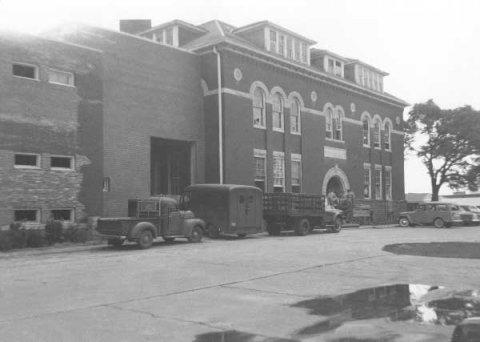Description:

Douglass High School was the first African-American school to open in Oklahoma City. Founded in 1891, the school had its humble beginnings in an abandoned two-room shed located on the corner of California and Harvey streets.
Hand-written minutes of the Oklahoma City Board of Education meeting detail the establishment of “The Colored School”, with J.D. (Jefferson Davis) Randolph serving as principal. Mrs. Emmettee Allison (Vivette), who was one of the first graduates, remembered the early days: “The school was flanked on one side by a livery stable, the stench from which made it necessary that the school population be moved just across the street to the north side.”
As the black community continued to grow and prosper in the Bricktown area, more and more children were enrolled. In the spring of 1903, the first graduation took place. Unfortunately, in the fall of that same year, the school burned to the ground, allegedly set on fire by arsonists who were never caught. Another school was built, this time out of stone, and was located where the Bricktown Ballpark now stands. By November of 1908, two more buildings had been added and enrollment stood at 581. The school developed a reputation for being one of the leading educational institutions in the region. Douglass High School remained in the Bricktown area until 1934, when it relocated out of the neighborhood.
Under the leadership of a new principal, J.H.A. Brazelton, the school added a football team, coached by Henry A. Berry, F.T. “Frenchy” Bruner, and Lucius L. McGee. Also expanded were the school’s athletics, art, home economics, music, and industrial arts programs.
Notable graduates include Ralph Ellison, Charlie Christian, Juanita Bolor, Jimmy Rushing, and Russell Perry. Outstanding leaders of the institution include Dr. Inman Page, former president of Langston University, J.A. Brazelton, founder of the Oklahoma Association of Negro Teachers, Dr. Frederick Moon, civil rights advocate, and Mrs. Zelia Breaux, the director of music who influenced the careers of many musicians.
Douglass High School was selected as the first high school to benefit from the Maps for Kids Initiative, celebrating with a grand opening on April 8, 2006. Among the new features of the $27.7 million facility are a mock courtroom, 8 science labs, a media center, two gyms, and a 1,200-seat auditorium.
Resources
Dulan-Wilson, Gloria. “Douglass High School of Oklahoma City: A Century of Excellence.” Crisis, 98.8 (Oct. 1991): 33-34.
Hawkins, Henry. “History of Douglass.” The Ebony Tribune, 27 July, 2001: 3.
Moore, Kendrick. Oklahoma City African-American Discovery Guide. Oklahoma City, OK: Oklahoma African American Trail of Tears, 2000.
“The Story of Douglass — a Historical Sketch.” The Ebony Tribune, 13 July, 2001.
Teall, Kaye M. Black History in Oklahoma: a Resource Book. Oklahoma City, OK: Oklahoma Public Schools, 1971.